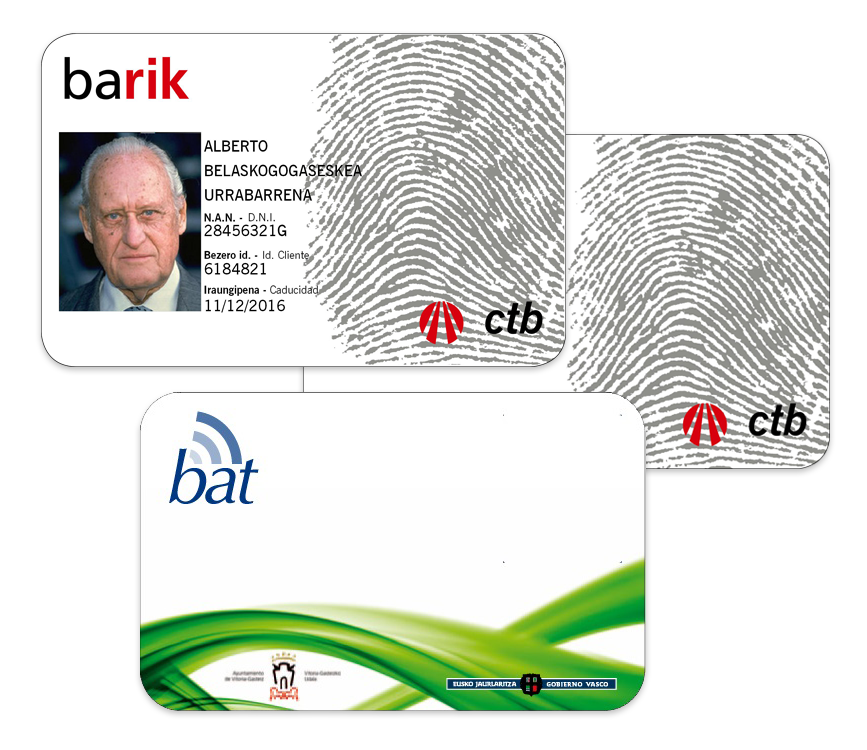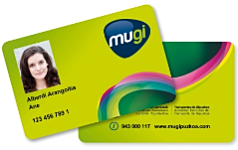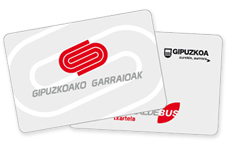Frequently asked questions (FAQ) about the paying with contactless cards on Dbus
1. What is the contactless bank card payment system project?
It’s a system that enables passengers to pay fares with contactless cards and mobile apps on all Dbus bus routes.
2. On which lines is it available?
Contactless card payment is available on all Dbus routes, both day and night.
3. Which cards can be used on Dbus?
All physical VISA, Mastercard and American Express cards can be used, regardless of the issuing bank, provided they have contact-free technology, which is identified with the following symbol: ![]()
4. Can I use my mobile to pay for my journeys?
The contactless bank card payment system also accepts payments with bank and telephone operators’ wallet apps, such as Samsung Pay and Apple Pay.
5. Where are EMV cards validated?
Contactless bank cards are validated when you get onto the bus, using the machine beside the driver. The machine is marked with the images of VISA, Mastercard and American Express.
6. Can I pay for my journey with my contactless card on the central platform?
People authorised to access via the central door (people in wheelchairs, people with walking frames and people pushing babies in strollers) should pay at the front of the bus, using the machine beside the driver and not at the machine on the central platform.
7. How much will I be charged for paying for my journey with a contactless card?
The fare payable when passengers use their contactless cards and mobile phones is the occasional rate in effect at that time for both day and night travel (búhos).
8. Can I use my bank card pay for both daytime and nightime journeys?
Yes. All Dbus routes are equipped for payment with contactless cards.
9. Can I pay for other people’s journeys with my contactless card?
Yes. You can pay for all the trips you like with your contactless card.
10. Can I change route for free with a contactless card?
No, you cannot change route free of charge when you pay with a contactless bank card.
Frequently asked questions about paying with QR codes on Dbus
1. What is the QR ticket payment system?
It’s a system that allows you to pay for a QR ticket using the official Dbus app.
2. What types of QR tickets are there?
There are four types of QR tickets:
– The 30-minute daytime QR ticket, which you can use as many times as you like on daytime services within 30 minutes of purchase. You can also change buses. The price is €1.85.
– The 30-minute night time QR ticket. This ticket can also be used as many times as you like on night time services within 30 minutes of purchase. The price is 2.50€ and also allows bus changes.
– The 24-hour QR ticket allows unlimited travel on both day and night Dbus services for 24 hours after purchase, and costs €6.
– The 48-hour QR allows unlimited travel on both day and night Dbus services for 48 hours after purchase. The price is €10.
3. On which routes can I travel with a QR ticket?
The QR code payment system can be used on all Dbus routes, both day and night.
4. How can I purchase a QR ticket and where can I validate it?
You can pay for your ticket with credit or debit card, entering the information in the official dbus app. If you like, you can save the information for future purchases. The payment system is secure and your payment is made through the Redsys payment gateway. When you buy the ticket with the app, a dynamic QR code is generated that is saved in the app itself. When you board the bus, validate your ticket on the machine next to the driver by holding your mobile screen upwards to scan the code from the dbus app.
5. Can I buy more than one QR ticket for several people?
Yes, you can purchase more than one ticket at a time, generating as many QR codes as tickets you purchase in the operation. These must be validated on the bus one at a time using the app.
6. For how long is the QR ticket valid?
The time your ticket is valid depends on when you buy it. You can use it within 30 minutes of purchase, or for 24 or 48 hours, depending on the type of ticket you have bought.
You can pay with VISA, Mastercard and American Express cards regardless of the issuing bank, provided they have contactless technology, which is identified by the following symbol:
7. Can I pay for my journey with a QR code on the central platform?
Authorised persons entering through the central door (wheelchair users, walker users and people with strollers with a baby or child) must pay for their journeys at the front of the bus using the machine by the driver, and not the machine on the central platform.
8. Can I change buses free of charge with the QR code?
Yes, provided you do so whilst the ticket is valid: 30 minutes, or 24 or 48 hours, depending on the type of ticket.
Frequently asked questions about Bat and Barik on Dbus
1. WHICH BAT AND BARIK CARDS ARE ACCEPTED BY DBUS?
All Bat and Barik Cards are accepted.
2. WHERE DO I VALIDATE MY BAT/BARIK CARD?
Validate your Bat and Barik cards when you get onto the bus, using the machine beside the driver. The machine is marked with the images of both cards. The card is not validated when you leave the bus.
3. CAN I GET ONTO THE BUS THROUGH THE CENTRAL DOOR WITH MY BAT/BARIK CARD?
Only authorised passengers are allowed onto the bus through the central door (wheelchair users, people with walking frames or with baby carriages with the baby and/or child inside). Passengers wishing to pay for their journeys with the Bat and Barik cards and who want to use the central doors must do so at the front of the bus, in the machine provided, and not with the machine on the central platform.
4. – CAN I VALIDATE OTHER PEOPLE’S JOURNEYS WITH MY CARD?
Personal Bat and Bark cards (with photos) are personal and non-transferable. They cannot be used to validate other passengers’ journeys.
Anonymous Bat and Barik cards (no photo) can be used to validate all journeys, provided the balance is sufficient.
5. – HOW MUCH IS CHARGED TO BAT AND BARIK CARDS BY THE VALIDATION MACHINE?
On Dbus buses, the fares charged to Bat and Barik cards are the same as the first stage of journeys with Mugi and Lurraldebus cards. Transfers between lines are not allowed.
6. – WHO IS ENTITLED TO ADDITIONAL DISCOUNTS?
General Large Families and Special Large Families are entitled to additional discounts with their Bat and Barik cards, with a fare of €0.76 and €0.47 respectively on a daytime ticket.
Frequently Asked Questions of Dbus about Fare Integration in Gipuzkoa
1. FARE INTEGRATION
– What is fare integration?
Fare integration consists in the unification of payment systems in public transport in Gipuzkoa, so that all the people of San Sebastian and Gipuzkoa can use the same card to use public transport throughout the entire territory.
– When is fare integration to be implemented?
Fare integration of public transport is already in operation in Gipuzkoa, and has been since 4 March 2013.
– Which means of transport are integrated in the new system?
Integration encompasses Dbus urban buses, Lurraldebus inter-urban buses, the urban buses of Rentería, Irún, Hernani, Arrasate, Eibar, Zarautz, Lasarte-Oria and Euskotren trains.
– Does DBUS still exist following integration?
Yes, Dbus still exists and will provide the same public transport system in San Sebastián as it has up till now. What changes is the fare system which is unified for all means of transport in Gipuzkoa. Transport cards are also unified.
– What is MUGI?
MUGI is the name of the new integrated fare system which offers the same card (Lurraldebus or Mugi) for all the means of public transport in Gipuzkoa that make up the integration system.
2. VALID TRANSPORT CARDS
– Which transport cards are valid for Dbus?
Transport cards valid for use on Dbus are the existing Lurraldebus cards and all the Mugi cards.
– What kinds of Mugi cards are there?
Below is a list of the different kinds of Mugi cards that you can use in all integrated means of transport:
o Ordinary Card
o Social Card
o Senior Card
o Disabled Card
o Youth Card
o General Large Family Card
o Special Large Family Card
o Anonymous card
– Do children need cards?
No, children under 6 travel free of charge on Dbus. Just ask the driver for the child’s free ticket.
3. REQUESTS FOR CARDS
– I need a new transport card. Can I apply for a Lurraldebus card?
No, from 6 February 2013, you can no longer apply for a Lurraldebus card. If you need a new card, you must apply for the Mugi card. Both the Mugi and the Lurraldebus are valid for travelling on Dbus.
– I need a new transport card. Where do I apply for it?
You can request a Mugi card in newsagents (newspaper kiosks, stationers, and authorised tobacconists), by post or in the Mugi website.
Check for the nearest application points:
> Check
4. TRAVELLING BY BUS
– Where and how do I validate the card inside the bus?
With Dbus you only validate on boarding the bus, and never on alighting. Remember that on Lurraldebus buses you will also need to validate on alighting.
– Do I have to validate on alighting?
No, on Dbus there is no need to validate the card on alighting from the bus.
– How much money is deducted from my Lurraldebus and Mugi cards when I validate them?
In the case of Dbus, the amount deducted always corresponds to the ordinary ticket, with a fare of 0.96 € in the 1-20 journeys bracket, 0.78 € in the 21-50 bracket, and 0.19 € after completing 51 journeys. (last bracked for free for youth card)
The subsidy corresponding to each group (youth, large family, social, senior and disabled) will be applied on recharging and never on the Dbus bus.
– What happens if there is no credit on my card?
Users with insufficient credit for validating the ordinary ticket in the corresponding bracket will not be able to validate their card on Dbus. In other words, all Lurraldebus and Mugi card users, irrespective of the subsidy corresponding to each of them, will not be able to validate their card if they do not have credit of 0.96 € in the first journey bracket, credit of 0.78 € in the second bracket and 0.19 € in the third bracket.
The subsidy corresponding to each group (youth, large family, social, senior and disabled) will be applied on recharging and never on the Dbus bus.
– Can I use my card to validate other people’s journeys?
All Mugi and Lurraldebus, except for the anonymous Mugi card, carry a photo and are personal and non-transferable and therefore do not entitle you to validate other people’s journeys.
The anonymous Mugi card was created for this purpose, to allow payment for several users with the same card. This card allows unlimited validations on Dbus provided there is sufficient credit. The price for each journey is 1,26 € in all cases. It also allows transfers between bus lines.
5. FARES
– How does the discount system for greater use of public transport work?
Discounts are progressive as the higher discount is applied for those who use public transport most frequently. Thus, the journeys made during the course of a month are counted, and are reset to zero the following month. The more journeys made during the month, the greater the discount on each journey.
The discounts are divided into three brackets:
o From 1 to 20 journeys, a discount of 47% is applied.
o From 21 to 50 journeys, a discount of 57% is applied.
o From 51 journeys, the discount applied is 90%. (Free or charge for Youth)
The discount is calculated on the basis of the occasional ticket, which costs 1.80 €, and in addition to these discounts are those corresponding to each special Lurraldebus and Mugi group. These discounts are applied on recharging the card.
The anonymous Mugi card is the only one not accumulating discounts or subsidies, as this card has a single fare of 1.26 €.
– What price will be discounted on the Lurraldebus and Mugi cards on validating?
On Dbus buses, the discount corresponding to the ordinary ticket is always discounted. This ticket costs 0.96 € in the 1-20 journey bracket, 0.78 € in the 21-50 bracket, and 0.19 € after the 51st journey.
The subsidy corresponding to each group (youth, large family, social, senior and disabled) will be applied on recharging and never on the Dbus bus.
– Which groups are entitled to discounts?
The Lurraldebus and Mugi groups with an additional discount are as follows:
o Social Group: 108% subsidy on recharging
o Senior Group: 108% subsidy on recharging
o Disabled Group: 108% subsidy on recharging
o Youth Group: 25% subsidy on recharging
o General/Normal Large Family Group: 25% subsidy on recharging
o Special Large Family Group: 100% subsidy on recharging
The subsidy corresponding to each group (youth, large family, social, senior and disabled) will be applied on recharging and never on the Dbus bus.
– When am I given a discount for belonging to a group with discount?
The discount for groups is applied when the card is recharged. For example, if a user in the Senior Group tops up their card with credit of 10 €, they will be given an additional 108% of this amount, with the result that the total credit will be 10 € + 10.80 € bonus = 20.80 € in total, plus the credit remaining before the top up. With this subsidy, the final discount for each journey is 52%.
– Are the journeys I make on other means of transport taken into account when calculating the number of journeys?
Yes, whenever they are part of the Fare Integration of Gipuzkoa system, that is, Dbus, Lurraldebus, Euskotren, the urban buses of Rentería, Irún, Hernani, Zarautz, Eibar and Arrasate.
Journeys made with Renfe do not count but can be paid using the Lurraldebus/Mugi ordinary card. The amount paid is the sum corresponding to Renfe’s ordinary ticket, and shall not be accumulated for progressive discounts.
– How much do transfers between Dbus buses cost? And in the case of other means of transport?
The transfers permitted between Dbus buses, as listed in the transfer table, are free, provided no more than 45 minutes pass between validation on the first bus and validation on the second. Cash payment of the tickets doesn´t allow free transfers. The transfer table is displayed on bus shelters and at the Dbus website, www.dbus.eus
Transfers between different operators (for example, Dbus and Lurraldebus) are for free.
– How much is the night fare? Are the night journeys taken into account when calculating journeys and applying discounts?
The night ticket costs 2.50 €, in the case of a single ticket and when using a card. These journeys with night fares are also taken into account for calculating journeys, and the journeys will be subsidized in the case of groups with the right to subsidy, as the subsidy is applied on recharging.
– Are monthly passes still available?
No, because the new system applies progressive discounts depending on use.
– From what age do children have to pay?
Children over 6 must pay in all means of transport included in the fare integration system, and must have their own Lurraldebus or Mugi Youth card, as both are currently valid. When travelling by Dbus with children under the age of 6, ask the driver for the child’s free ticket.
6. TOPPING UP
– Where are the Lurraldebus and Mugi cards recharged?
Lurraldebus and Mugi cards can be recharged at newsagents, post offices and in over 200 specially equipped Kutxabank ATMs.
In San Sebastian it is also possible to top up your card at the machine on Avenida de la Libertad 20, where it intersects with Churruca St. and at the new San Sebastian Bus Station.
Another option is to top up through the Mugi website. These top-ups can be activated on Dbus buses. Some details:
- Recently acquired cards should be topped up for the first time at a kiosk and you must pay for at least one journey with the card. You will then be able to register on the Mugi website to top up the card and activate your purchase on Dbus.
- Online recharges are available on Dbus buses approximately 20 minutes later.
- Top-ups can only be activated with the new dispensing machines by the driver’s position. They cannot be activated with other machines.
- When a person using a wheelchair or with a stroller gets onto the bus, he or she must go to the machine by the driver to activate the top up.
- These machines activate top ups, but cannot be used to purchase a top up for your card.
- Every time you top up your card, the dispenser will print out a balance, which the driver will keep, unless the user requests it.
- Your top up will be activated as soon as you pay for a journey with the card. Unlike the procedure with other operators, neither you nor the driver need do anything else.



